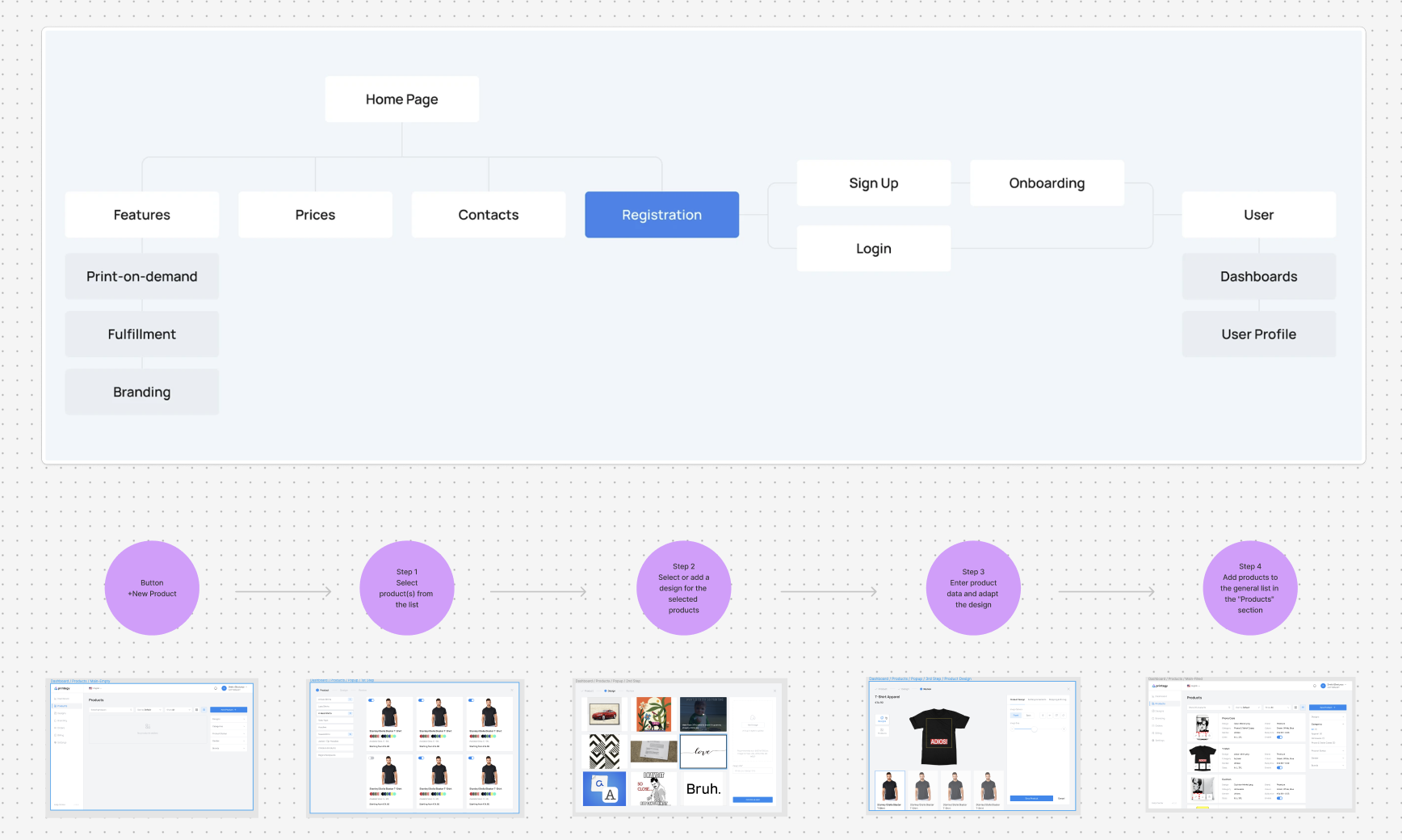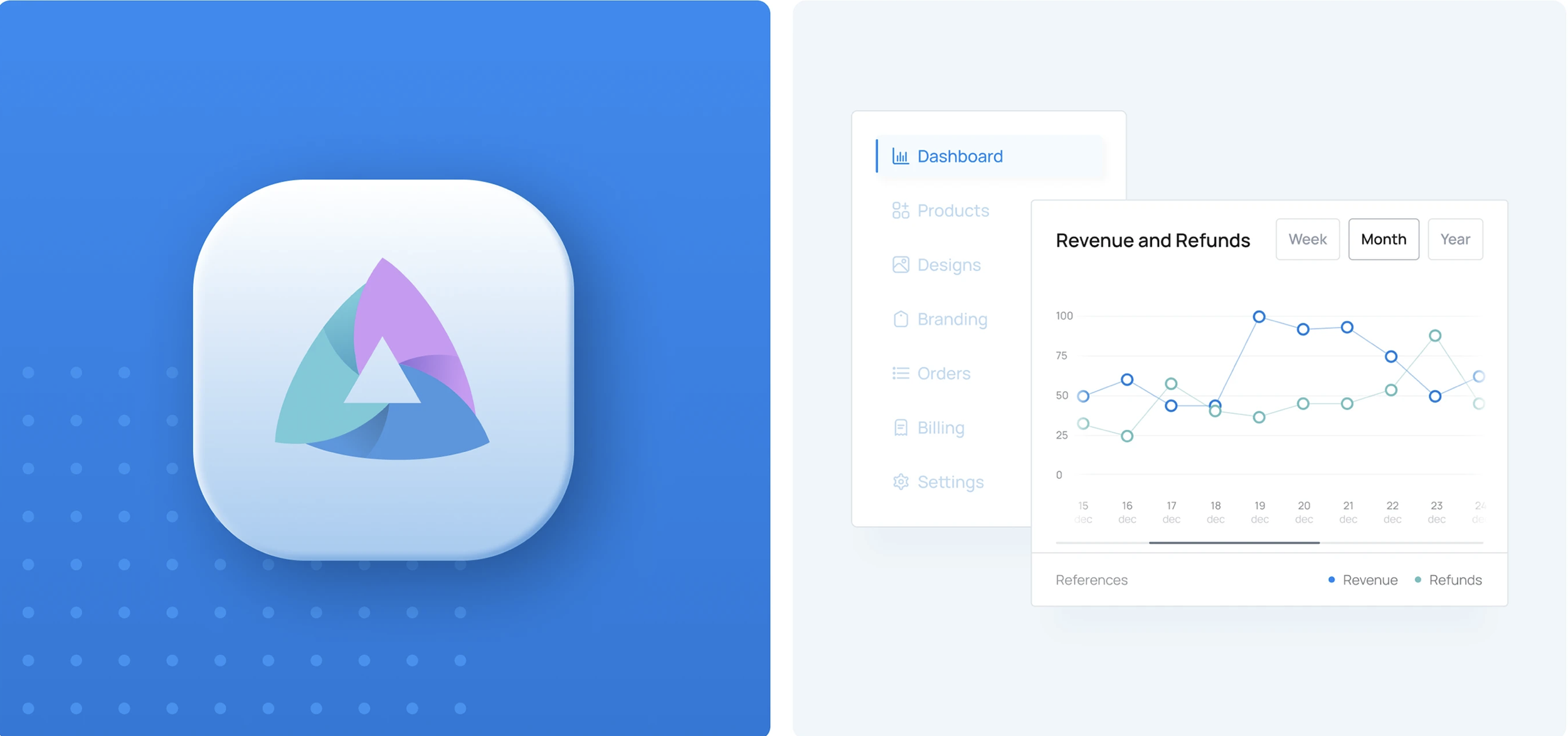Printegy - Print-On-Demand Shopify App
Printegy is a print-on-demand platform that helps creators easily set up, design, and launch their own custom product store on Shopify — without technical complexity. With fast local production in Germany, curated bestsellers, and built-in mockups, Printegy streamlines the entire process from idea to first sale.
Role: Lead UX Designer
Timeframe: June 2022 - May 2023
In 2023, two friends running Shopify stores in Germany saw a common pain point among their peers: selling custom products was hard. Between production, fulfillment, and inventory management, many entrepreneurs gave up before even launching.
They envisioned a better way — a tool that would let sellers focus on creativity and sales, without worrying about operations. That idea became Printegy, a print-on-demand app built to help Shopify sellers turn ideas into income with zero hassle. I joined as the Lead UX Designer to help turn that vision into a usable product.
The Challenge
Print-on-demand (POD) tools are everywhere — but many are cluttered, overly technical, or built with high-volume sellers in mind.
At the same time, entrepreneurs of all levels want to sell custom products without the headaches of production, inventory, or fulfillment.
We set out to remove those barriers and help sellers turn ideas into income through a seamless, Shopify-integrated POD experience. Instead of more features, we focused on doing the essentials — faster, clearer, and with less friction — for everyday sellers who value simplicity and speed.
What was done
As Lead UX Designer, I was responsible for shaping the full product experience:
Defined the product architecture and key flows from onboarding to publishing
Led user research with Shopify merchants to uncover real pain points
Designed the core information architecture and logic behind key flows
Collaborated closely with the PM and engineers to ensure feasibility
Managed external UI designers to ensure pixel-perfect execution and brand consistency
Impact
The app launched successfully on the Shopify platform, attracting early adopters from competing solutions. It received positive feedback from merchants, reflected in a 4.9 average rating, highlighting the clarity and usability of the seller experience.

Understanding Merchants
Launching a product should feel exciting — not exhausting. But for many Shopify sellers, just getting from a design to a live product can feel like navigating a maze. Between technical jargon, endless product options, and unclear steps, what should be a creative process quickly turns into a source of frustration.
Through early research, I uncovered core friction points:
Many first-time sellers were overwhelmed by POD setup. Flows were confusing, with too many decisions upfront
Product variety often created decision fatigue
In most tools, mockups were either missing or came too late, making sellers feel unsure about the final product
There was a constant fear of wasting time and effort on something that might not sell
Many sellers felt unsure how to price products profitably, especially with high base costs and hidden fees.
“I tried launching a sweatshirt line, but by the time I picked the style, figured out sizing, and set a price that didn’t scare people off, I still hadn’t seen a decent mockup. I ended up publishing without knowing how it would actually look, and when the sample arrived, the print placement was off — I felt like I’d wasted a week.”
Defining the opportunity
Through early research, I heard repeated friction points: confusing flows, late mockups, unclear pricing, and long production times. To move from observation to action, I reframed these struggles into focused “How Might We” questions — each one pointing at a specific moment where sellers felt stuck, uncertain, or unsupported.
These questions helped define where design could truly make a difference — not by adding more features, but by making the core experience work better.
Value Proposition
Instead of trying to compete on scale or complexity, we focused on the four areas that mattered most to sellers: simplicity, visual clarity, production speed, and margin transparency.
These became the foundation for Printegy’s value proposition — a product designed to reduce friction, not create new ones.
A simple setup that gets out of the way
Printegy focuses on fewer, clearer options — helping merchants launch faster and stay focused on selling rather than configuring.
High-quality mockups that actually help sell
On many platforms, mockups appear late or cost extra.
Printegy offers free, realistic visuals upfront — allowing sellers to clearly represent the product before publishing.
Orders are produced faster — not just promised faster
While others list 3–7 day production windows, Printegy consistently fulfills in 1–2 business days, including peak periods, thanks to in-house production in Germany.
A chance to price things without losing money
With competitive base prices and transparent shipping costs, Printegy makes it easier to offer attractive retail pricing while maintaining a sustainable margin.
When mapped against existing platforms, these priorities revealed meaningful gaps.
While many tools offer similar catalogs or integrations, few deliver on the basics sellers actually rely on — especially when just starting out.
The table below highlights where Printegy’s focus aligns directly with those unmet needs.
Turning Vision into Product Architecture
Once we clarified Printegy’s core value proposition — helping creators easily launch and manage a custom product store — the next phase focused on execution. Print-on-demand platforms are complex systems, often requiring thoughtful logic to support product customization, order flows, and fulfillment management.
Much of the design work shifted toward defining this complexity: writing detailed documentation, mapping user flows, and closely collaborating with developers to ensure the logic was scalable and technically feasible. The platform architecture and product creation flow you see here are just a snapshot of that effort. My role included designing key flows, structuring component logic, and creating interaction specs to make sure we weren’t just building features, but building the right ones, in the right way.
Designing the UI
Once the foundation was in place, I moved on to the visual design. It was both challenging and rewarding to shape a UI system that felt modern, approachable, and functional. I worked collaboratively with a remote contractor team — setting the visual direction, defining the and ensuring consistency across screens. This stage brought the product to life and was a great balance to the deeply systematic work that came before.
Launching the MVP & Early Feedback
After months of iteration, alignment, and collaboration, we launched the MVP to a closed group of 7 early users — primarily Shopify store owners and graphic designers testing POD products.
The goal was to validate the full flow: from product creation, design upload, pricing setup, to seamless export into Shopify — and uncover any blockers before scaling further.
We supported users through onboarding calls and async feedback loops over a two-week period. Here’s what we saw:
5 stores processed real orders using Printegy, successfully fulfilling them through our system
6 users returned to create additional products, confirming clarity and efficiency in the main flows
Feedback pointed to strong time savings and usability.
“I’ve used POD platforms for a couple of years, but Printegy is the first one where everything just feels smooth. Orders are processed faster, the interface is way more intuitive, and the pricing is refreshingly fair — it finally feels like a POD tool that respects both my time and budget.”
Final Thoughts
Collaboration is the engine of good product thinking.
From internal alignment to working with devs and contractors, the best solutions came out of conversations.
Building for complexity means constantly negotiating clarity.
Designing a POD platform revealed how important it is to make layered systems feel intuitive — for merchants, not just for tech teams.








